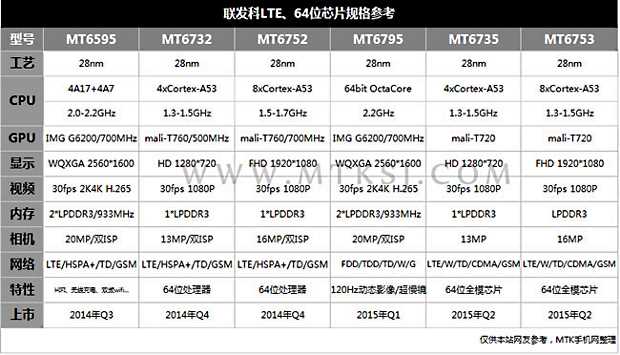More and more phone models are utilizing the quad-core MT6732 and octa-core MT6752 64-bit chipsets; the latter going into phones under the high-end category, while the former into low-end phones. While the MT6732 is tagged as low-end, its benchmark test results are still quite impressive, and at par with the popular 32-bit MT6592 that carries twice as many cores.
MT6753
MediaTek is now launching a mid-ranger in the MT67xx series, the MT6753. Same as the MT6752, it will be equipped with 8 ARM Cortex-A53 cores with 64-bit architecture, but will be clocked at lower speeds: between 1.3 GHz and 1.5GHz. The accompanying GPU is the Mali T720, which is clocked at the same frequency at the Mali T760.
The chipset will be able to support 1080p resolution displays as well as camera sensors that go as high as 16MP in resolution. The MT6753 will also be LTE capable, with support for FDD-LTE with CAT 4 data transfer speeds. This is, of course, in addition to WCDMA, T-SCDMA, GSM support, while also feautring CDMA 2000 1x, and EVDO connectivity.

MT6735
Another chipset to be released in Q2 of 2015, alongside the aforementioned chipset, is the MT6735. This is a 4-core counterpart of the MT6753, whose processor will also be clocked at 1.3GHz-1.5GHz and will sport the same GPU, the Mali-T720. Network support is also the same as the MT6753, ranging from 2G to 4G network capabilities, with the additional CDMA 2000 1x and EVDO support.
Discuss this article at www.chinaphonearena.com
Phones that will utilize the MT6735 chipsets will have camera sensors limited to 13MP, while their displays will peak at 720p resolution.
Both chipsets will be using the same 28nm die sizes. It seems MediaTek doesn’t want to concern themselves too much over Qualcomm’s boasted 14nm FinFET packaging. Aside from focusing on their 10-core and 12-core development, MediaTek is more intent on coming up with low-cost-yet-powerful chipsets.

Leave a Reply